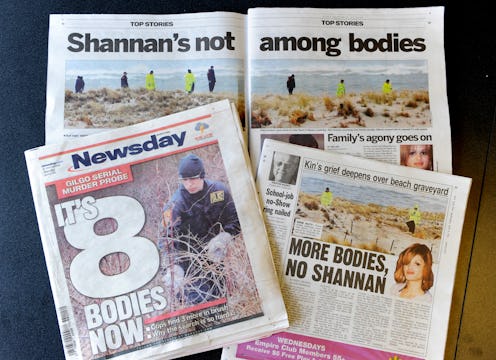Entertainment
'Killing Season' Highlights Active Serial Killers
When investigators Josh Zeman and Rachel Mills began filming A&E's new series The Killing Season, they planned to focus on the Long Island Serial Killer (also known as LISK). LISK, who remains at large, is responsible for the murders of multiple sex workers whose bodies were discovered on Gilgo Beach in late 2010 and early 2011, wrapped in burlap sacks. Four of the victims were killed in the same manner and had advertised their services on Craigslist. But, as police continued combing the beach, more bodies were discovered — and the victims didn't match the same modus operandi. To further complicate the case, Zeman and Mills found parallels between the first four victims and sex workers who had gone missing or been murdered in different states. Although the investigation is ongoing, many believe that multiple killers discarded their victims' remains on Gilgo Beach. It's a chilling thought and it leaves me wondering how many serial killers are active in the United States?
The exact number is unknown because, like LISK, they haven't been apprehended yet. And LISK is not an anomaly when it comes to choosing his prey — sex workers are 18 times more likely than other women to be targeted by a serial killer, as reported by Salon. The outlet quotes the Green River Killer, who offered this chilling explanation:
I picked prostitutes as victims because they were easy to pick up without being noticed. I knew they would not be reported missing right away and might never be reported missing. I picked prostitutes because I thought I could kill as many of them as I wanted without getting caught.
A similar sentiment is echoed in The Killing Season, in which the missing and murdered sex workers are described as "the missing missing" — women whose disappearances aren't taken seriously until it's too late.
First things first — what criteria is necessary to label someone a serial killer? As defined by the FBI, serial murder is “the unlawful killing of two or more victims by the same offender(s), in separate events.” The perpetrators of massacres such as Virginia Tech, Sandy Hook, and Pulse Orlando are labeled as "mass murderers" rather than serial killers. In short, serial killers stagger out their killings (like LISK), while mass murderers kill multiple people in one incident.
Now that we know mass murderers are in a class of their own, let's take a closer look at the number of serial killers in America. Of course we don't know the exact number because, well, they haven't been apprehended. But, according to John Douglas, a former chief of the FBI’s Elite Serial Crime Unit, “[a] very conservative estimate is that there are between 25 and 50 active serial killers in the United States” at any given time, as reported by People. This number is frighteningly high, but less than one percent of murders each year are committed by a serial killer — so, in that sense, serial murders are rare. Still, it's unnerving to know that at least 25 serial killers are currently walking among us.
As you watch The Killing Season, it becomes increasingly clear why the exact number of serial killers can't be pinpointed. Some of them change their entire modus operandi in an attempt to evade law enforcement, while others criss-cross the country for the exact same reason. What we do know is that sex workers are at grave risk — and they are often re-victimized even after their deaths by people who don't take their disappearances seriously or say they "should have known better."
Filming The Killing Season was a physically and mentally demanding experience — but Mills tells Bustle that the hardest part was witnessing the plight of the sex workers she met during the investigation: "If I'd had a different path through no fault of my own, I could have been in their position quite easily," she says. "They're human and they don't want to be there. When I looked them in the eye, I could really see that pain."
Image: A&E
